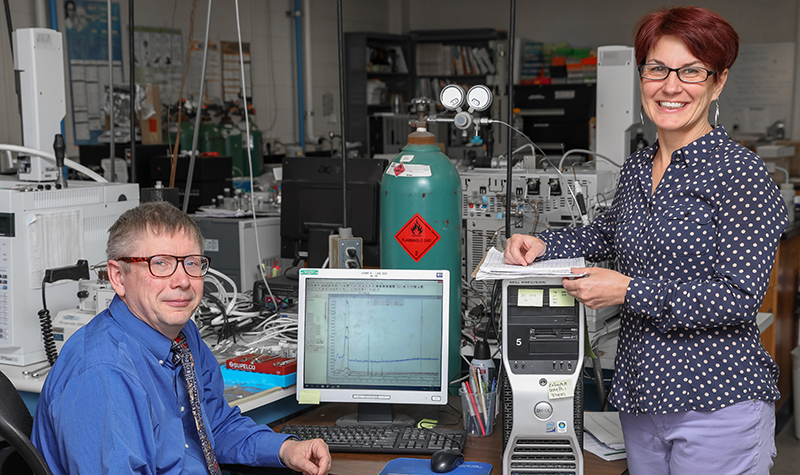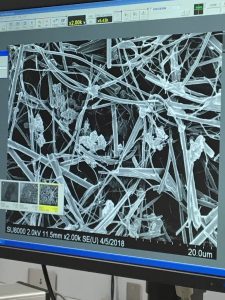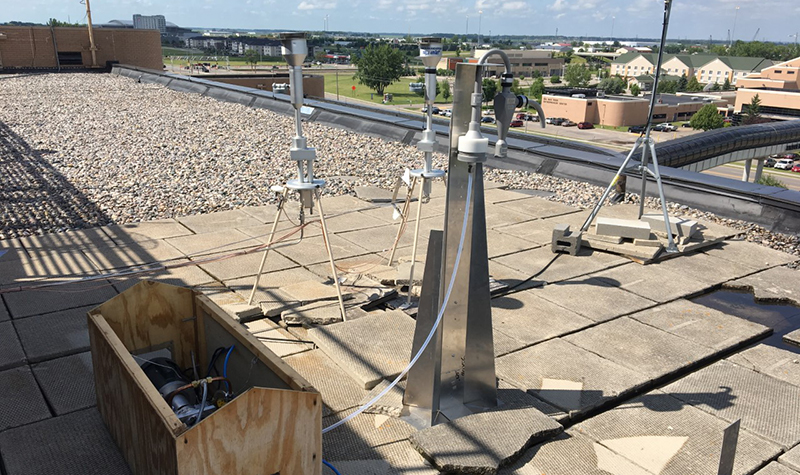05 Jun UND scholar’s novel method could upend basic tenets of air research

Alena Kubatova and Jenya Kozliak, both chemistry professors at UND, engaged in a novel, comprehensive air study that pulled faculty from the departments of chemistry, atmospheric sciences and chemical engineering. The research sprang up from the master’s thesis of Brett Nespor, who has since graduated. Photo by Jackie Lorentz/UND Today.
What was to be Brett Nespor’s master’s thesis, expounding on an air study done nearly five years before he arrived on campus, morphed into an invaluable endeavor that could alter the conventions of chemical research.
Utilizing and optimizing a method developed by University of North Dakota Chester Fritz Distinguished Professor of Chemistry Alena Kubatova, Nespor probed air particles to identify their origin through a technique that reveals much higher quantities of them than commonly possible.
“You are never going to be able to determine every single compound that is in your sample and where it came from,” said Nespor, who has since obtained his master’s degree in chemistry, “but the idea is to get the best idea possible where [it] is coming from and what the sources could be.”
Let’s begin with the fundamentals that bear cues to the inventiveness ingrained in the project, which brought together Nespor and faculty from the departments of chemistry, atmospheric sciences and chemical engineering.
Air teems with particulate matter, microscopic specks released by a slate of actors and activities – from plants to humans, from the scorching of trees to the burning of gasoline.
“They can be solid or droplets,” said Kubatova, who advised Nespor. “You can put an average of 20 of these particles on a cross-section of a hair. That is how tiny they are. The trouble with them is because they are small, they penetrate lungs and they can travel long distances,” even across oceans.
Nespor looked at organic particles, or those composed of carbon, hydrogen and oxygen. There are hundreds of such compounds, often present in tiny amounts, all embedded within the matrix of particular matter. Yet, current approaches to air analysis detect only some 30 percent of them.
“If you characterize 30 percent and say, ‘These particles are all biogenic [plant-based] emissions,’ does that represent the whole particulate matter or not,” Kubatova said.
Driven by this inquiry, she has strung together a process that spouts the “full scope” of air-borne organic matter by bypassing the standard application of chromatography, or the use of a solution to separate a mixture.
“What Dr. Kubatova set out to do is to develop chromatographic methods of analysis of something that is not chromatographically accessible and analyzable,” said Jenya Kozliak, chemistry professor who collaborated with Kubatova and Nespor. “This is the novelty.”
Novel but not rocket science
So, how does it actually work?

A closeup of an air filter. Photo courtesy of Brett Nespor.
The process carries a lengthy name – thermal desorption pyrolysis gas-chromatography mass spectrometry (or TD pyrolysis GC-MS) – that, to a maven, divulges its inner mechanics. To grasp its newness, however, a layman needs to know what the usual procedure entails.
Once air filters are collected – at UND, this happens atop Clifford Hall – their contents traditionally soak into a solvent before being extracted into a solution, a task that often requires several rounds to ensure the presence of all air particles.
Then, through gas chromatography, the solvent is incrementally heated to up to 300° Celsius (or nearly 575 Fahrenheit), a temperature that disassociates volatile components or that 30 percent of the sample.
What UND researchers do is shirk the solution and directly subject the components stuck to a filter cutout to evaporation (thermal desorption), high-temperature breakdown (pyrolysis), separation (gas-chromatography) and, finally, identification of each present chemical by its mass and specific signature (mass spectrometry).
“It all sounds like rocket science but it is not,” said Kozliak. “It is just a matter of taking a few classes in chemistry and then a person can comprehend it. The rest is getting it done right, accurately, meticulously, precisely.”
The precarious yet creative part of the research lies in the fact that the detection of most particles – the grail beyond a mere 30 percent – requires their physical collapse through high temperature and later their virtual assembly through painstaking analysis.
Heated to some 900° Celsius, three times higher than the usual, compounds disintegrate into pieces that must be assembled back together in order to determine their source, which is the very goal of the study. This is harder than it sounds.
There are hundreds of chemicals in Nespor’s samples and some of them break into a dozen of morsels, stirring what Kozliak described as a “soup of chemicals.”
“When you break down any molecule, most studies show only partial recovery, so they keep missing pieces,” Kubatova said. “One part of the research is doing the analysis correctly, so we actually recovered in our previous studies biofuel intermediates with 100 or 95 percent [completeness].”
Often times, nonetheless, basic exercises could prove profound in complex research like this. For instance, Kozliak’s simple conversion of grams into moles, a chemical unit of amount, reconstructed a biofuel composition that had previously evaded recognition.

The roof of Clifford Hall hosts air collection devices that function akin to giant sucking pumps. Photo courtesy of Brett Nespor.
A high aim
In his second semester at UND, Nespor, who then joined Kubatova’s research lab, commenced the research with re-analyzing old air particulate matter samples that had been frozen to -20 ° Celsius in order to withstand time. Later, he collected his own samples – a task that takes up to a week of constant sucking of air through filters the size of a coffee-cup saucer.
“This was intended as a small project but Brett expanded it and converted it to a really big and meaningful project, which will be continued,” said Kozliak.
Aside from presenting a new modus of air analysis, the undertaking showed the relative “cleanness” of the air around Grand Forks, where most compounds originate from agriculture.
“In theory that is better than the particles that are coming from a factory but it is still all relative,” said Nespor. “If you were to inhale a lot of crop dust that is also not going to be good for you.”
Yet, it is the method that yielded this conclusion that can engineer “a whole new development in our field,” Kubatova said. Because of that, the research team is striving to publish a paper in the highly regarded journal Environmental Science and Technology.
“We are aiming high,” Kubatova said.
Personal mission
Submission and subsequent publication, hence, command thorough scrutiny of both data and words – to the extent that full section rewrites often occur.
It is a rigorous venture that Nespor partakes in from his hometown outside of Winnipeg, where he serves as an educational assistant in a school and explores ways to work on environmental challenges. For him, it is a passion sparked by his research at UND.
“The results we find are hopefully used for the greater good of the people so that people are not breathing contaminated air or drinking contaminated water,” he said. “That is the idea of a lot of these environmental studies – to protect people from harsh conditions.”


